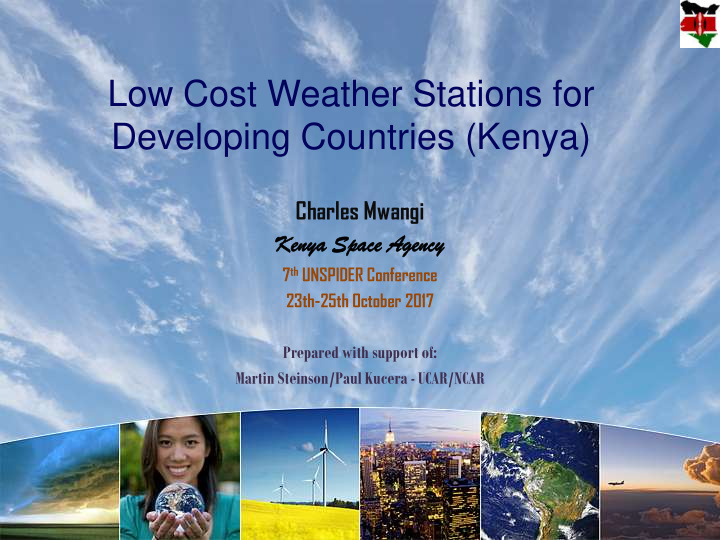



Low Cost Weather Stations for Developing Countries (Kenya) Charles Mwangi Ken enya a Space ce Agen ency cy 7 th UNSPIDER Conference 23th-25th October 2017 Prepared with support of: Martin Steinson/Paul Kucera - UCAR/NCAR
Outline • Need for weather data for agriculture and disaster management • Low-cost 3D-Printed Automatic Weather Station (3D-PAWS) • Evaluation, testing and calibration results of 3D- PAWS • Deployment of 3D-PAWS in Kenya • Linkage with Educational program (GLOBE program) • Access and visualization of the collected data • Associated cost of development of 3D- PAWS…
Need for weather data in Kenya • In Kenya, approximately 75% of the population depend on subsistence farming and its Kenya’s most important economic activity • Common disasters that affect Kenya includes floods, landslides and drought As such, there is need to map and predict water and • weather patterns for agriculture as well as disaster management. EO data provides critical data but there is still need for • fusion of this data with in-situ measurements To deploy a system of in-situ measurements, there is need • for a huge investment in infrastructure and human capacity Convergence of technologies of micro-sensors, computing • capabilities and wireless communication can provide a framework for in-situ measurements In disaster management, there is need for a real-time, •
3D-Printed Automated Weather Station (PAWS) Weather Station • Uses 3D printers – inexpensive Sensor Platform technology • Use low-cost, reliable micro-sensors • The system is fabricated, assembled as well as maintained locally • “Print and replace” components when systems fail • Enable local agencies to take ownership in building and maintaining observation networks • Data collected will provide ground- based benchmark and cross calibration standards for multi EO satellite sensors
3D-Printed Automated Weather Station (PAWS) Radiation Shield and State Power and Variables: Pressure, Temperature & Communicati ons Solar power Humidity solutions & Solar Battery Cellular data communication (modem, dongle)
3D-Printed Automated Weather Station (PAWS) Data acquisition and communicatio n Raspberry Pi Zero (Single Board Computer) Wind Direction Solar Radiation Wind Speed Precipitation Rate
Computer Aided Drawing 3D-PAWS Models Design Instrument designs are developed using an open source computer aided drawing (CAD) software tool : http://www.openscad.org
Sample 3D-Printer Setup 3D Printer, Plastic Filament, and Computer Aided Drawing Software
3D Printed Weather Station Sensor Designs Wind Radiation Speed Shield Precipitati Wind on Direction
3D Printed Weather Station Component Designs Computer Push Fit Junction Housing Circuits Box Connectors ~ 120 components of the weather station are 3D printed
Evaluation, Testing and Calibration of 3D-PAWS • Sensors calibrated and evaluated testing at the NOAA Testbed in Sterling, VA – Calibration & Failure conditions • Evaluation of sensors is conducted at the NCAR NCAR Testbed NOAA Testbed Marshall Research Facility in Boulder, CO and at the NOAA Testbed Center in Sterling, VA • Sensor observations are being compared with calibrated commercial reference sensors • Observations are matched at 1-min resolution to compute error estimates of the 3D- PAWS sensors
Temperature 3D-PAWS Evaluation Results • 3D-PAWS temperature comparison shows good agreement with Campbell Scientific (CS) 500 series sensor • Root Mean Squared Error (RMSE) = 0.4° C • 3D-PAWS Relative Humidity (RH) Relative Humidity comparison shows a larger uncertainty with the CS 500 sensor • RMSE = 5% • Low bias at high RH Results from the NCAR Testbed Site • High bias at low RH
3D-PAWS Deployment in Kenya 11 Weather stations have been installed in GLOBE schools in the following regions; • Nairobi (2) • Nakuru (1) • Nyandarua • Bungoma (1) • Uasin Gishu (1) • Kakamega (1) • Homabay (1) • Transmara (1) Additional stations • Regional Centre for Mapping of Resources for Development (1) • Kenya Meteorological Department (1)
Some of the Kenya 3D-PAWS Sites Bushiangala School Naivasha School Magomano School
Connecting 3D-PAWS to GLOBE Program * GLOBE Program is an international Earth science and Environmental education program. * GLOBE protocols on Atmosphere, Hydrosphere, Biosphere and Pedosphere (soil) that has generated over 145 million in-situ measurements . * Actively involved in validation of data from satellite missions such as cloudsat, GPM, SMAP etc * Provides a framework for GLOBE Program is supported by NASA and NSF http://www.globe.gov students to collect and analyze environmental data
Evaluation of Observations at GLOBE Schools Inter-comparison of precipitation and temperature Temperature Sensor Inter- comparison observations by 3D-PAWS Between BMP180 and HTU installed in the GLOBE schools 3D PAWS and Manual Precipitation in Kenya Gauge
3D-PAWS Open Data Access Data stored locally at each station o 2+ years of data can be stored on local storage drive Real-time Access: o Web-data services (CHORDS) o Local HydroMet Office climate data services o GLOBE and other network data services Data currently hosted by: CHORDS ( C loud- Ho sted R eal- To access and visualize data, visit time D ata S ervices for • http://3d.chordsrt.com (Global) Geosciences) data-portal • http://3d-kenya.chordsrt.com Visualization of 3D-PAWS Data (Kenya) Portal (Kenya)
3D-Printed Automated Weather Station (PAWS) Component Estimated Cost (USD) - Initial setup cost for each local network $5000 + 3D-printers, tools, supplies (wires, connectors, solder) Mounting Components (pipes, brackets, guy $100/site wires) Raspberry Pi and power cable $60/site Micro-sensors for temperature, pressure, $100/site humidity, wind, and precipitation 3D Printed Plastic filament for instrument $60/site housing Power Commercial Power: minimal cost Solar power/battery system: $50/site Communications Wireless USB: minimal cost Cell Modem: $30/site* Satellite Modem: $50/site*(alternative) +Recommend purchasing two to three 3D printers to provide additional printing capability and backup resources *The cost doesn’t include the monthly or yearly service costs.
3D-Printed Automated Weather Station (PAWS) Planned New Sensor Time Frame Development Soil Moisture/Temperature Late 2017 Lightning Detection Late 2017 Stream/water flow gauging Early 2018 Air Quality (Ozone, PM2.5), etc. Early 2018 Heated Precipitation Gauge Mid 2018 Martin Steinson Paul Kucera
Application Development • Applications using weather station observations: – Weather forecasting – Early Warning Systems • Flash flooding • Severe weather – Making engineering decisions • Water resource management • Agriculture Email: maina.charles@gmail.com Thank you…
Recommend
More recommend